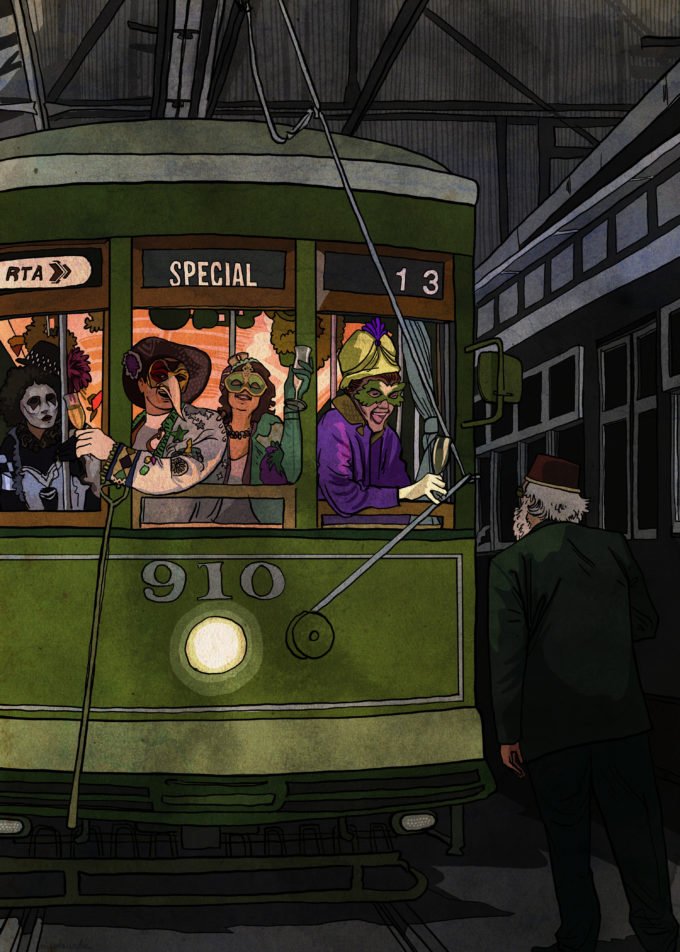
In Transit: How to Navigate New Orleans
Despite its relatively compact size, New Orleans can be a distinctly tricky town to navigate—for locals and visitors alike. But it’s not any particularly wonky directional twists and turns or logistical hurdles that make gliding from Point A to Point B so difficult: It’s the dueling forces of messy infrastructure and curiously draconian transportation options. How do you stop a few sinkholes or a traffic-camera ticket from spoiling a good time? Read on.
Louis Armstrong New Orleans International Airport (MSY)
First things first: The New Orleans airport is about a 30-minute drive away in nearby Kenner, which means you’re going to be in for a fairly pricey ride both coming and going, depending on traffic and time of day. (Naturally, avoid rush hour, when you can.) When landing, if you opt for a ridesharing service like Lyft over a cab, the pick-up location is tucked away in the parking garage across from the flow of arrival traffic, so be prepared for a bit of a strut. Have a delayed flight or a long layover? Dining options inside MSY have been dismal for years, but that’s all about to change thanks to a $807 million renovation (including a brand-new terminal) currently underway. What’s more, the upgrade—slated to finish in 2018—will feature a smorgasbord of new restaurants and bars from some of the city’s most celebrated chefs, like Susan Spicer and Leah Chase. And, yes, as the airport’s jazz-inspired name suggests, there will be some sort of live music ready to great you during most normal business hours.
Driving in New Orleans
If you’re driving into New Orleans, as soon as you hit the parish line, flip your radio dial over to WWOZ (90.7); it’s the musical heartbeat for the city. Checked that off? Good, now you’ll at least have the proper soundtrack if traffic snarls and craters rear their ugly head. Driving in New Orleans is like a full-contact sport, and extra vigilance is necessary when behind the wheel, even for those adept at the congestion of city driving. The streets themselves are perhaps the biggest Waterloo, with cavernous potholes and unexpected cracks large enough to pop a tire (or three). New Orleanians also have a propensity for being in the middle of the street for reasons both sanctioned and unsanctioned: parades, second lines or just because someone felt like shutting down their for a barbecue are all frequent excuses. Going slow is necessary, and be prepared for snags.
Another reason for going slow are an abundance of traffic-light cameras, which have a hyper-quick trigger if you’re speeding through an intersection—even a little—or roll through a stop sign. Don’t have a ticket waiting for you when you get home.
The cardinal directions also disappear in New Orleans. When asking for instructions, locals are likely going to explain your whereabouts in terms of Lakeside, Riverside, Uptown, and Downtown. Lakeside (towards Lake Pontchartrain) is what the rest of the world calls “north,” Riverside (towards the Mississippi River) is south, Uptown (up the river) is west and Downtown is east. Don’t worry—you’ll get the hang of it.
And if you’re playing passenger? On the whole, taxis are far less reliable (and timely) than ridesharing services.
Riding the Streetcar
Ah, the whimsical charm of the streetcar (never call it a trolley—seriously). For $1.25 a ride (or $3 for an all-day pass, exact change only), you, too, can roll your way down St. Charles Avenue or Canal Street while sipping a Sazerac and feeling like a dandy of yore. Sure, the streetcar isn’t the most useful way to get around—set routes only serve certain (visitor-heavy) areas of the city, and leave out massive swaths of New Orleans equally worthy of exploring—but for destinations near a streetcar stopping point, the experience alone can be worth it. With five dedicated tracks that run both along the streets and through neutral ground, it’s a means of transportation that’s often more about the journey itself than the destination. Just be forewarned: Delays are frequent, and the St. Charles line (arguably the most popular) has no air conditioning. Get ready to bump up against some sticky bodies.
Biking in New Orleans
Saddling up for a bike ride in New Orleans is a bit of a double-edged sword. On one hand, the city has come a long way in recent years (thanks to a slew of highly motivated cycling advocates) when it comes to dedicated bike lanes and pathways from the Central Business Direct to the Lafitte Greenway. There’s even a bike-share program now, which launched with cautious optimism in Fall 2017 and charges $15 a month for bikers to ride up to an hour each day. Progress has been made. But the flip side of biking in New Orleans is that it can be a safety crapshoot: Many drivers still don’t respect bike lanes—especially the one on Baronne Street—while road debris and poor pavement cause serious accidents on a weekly (daily?) basis. What’s more, bikes are picked off by thieves with alarming regularity. You’d be hard pressed to find a New Orleanian who hasn’t had their two-wheeled ride (or at least the tires) jacked at some point. Always wear a helmet, and ride with caution.
Getting Around on Foot
Whether you’re shopping the entire length of Magazine Street, or meandering through the alleys of the French Quarter with a cold one in your hand, there’s almost no better way to peruse many of the business-heavy areas of New Orleans than by foot. One important rule, though: Never walk alone after dark, especially down side streets or through unlit areas. Crime in the city is, unfortunately, no joke.
Get the App—or Don’t
There are several New Orleans transit apps that attempt to track the location and wait time for various public transportation routes, from buses to streetcars. None works quite right. You’re better off with a paper map and plenty of time built in as a cushion.